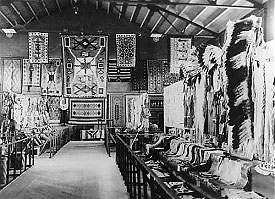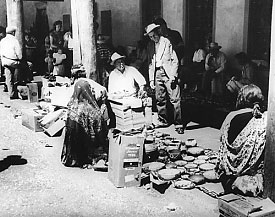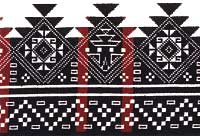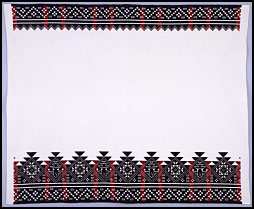History
Culture
Design &
Technique
How
To
Artists
Convocation
Glossary

Home
|
The Persistence of Pueblo
Embroidery
Since the early part of the twentieth century, Anglos have questioned
whether Pueblo embroidery could survive as an actively-practiced
craft. All Americans today practice fewer handcrafts than did
people a hundred years ago. However, for a variety of reasons,
Pueblo people are more likely than non-Pueblos to continue practicing
traditional arts of all kinds.
|
Pueblo
Stitch
Types of Garments
Mantas
Breechcloths
Kilts
Dance
Sashes
Yarns & Fabrics
Persistence
Spotlight: Evelyn
Bird Quintana
|
|
|
| |
|

Gathering of archaeologists and others involved in the
creation of the Laboratory of Anthropology
(c. 1930).
Starting in the
late 1910s and on into the 1920s, the Southwest, especially the
Santa Fe area, became a magnet for a particular type of well-heeled,
educated Eastern Anglo. Many of the newcomers believed that the
Pueblos enjoyed an especially strong, grounded culture whose
traditions, including their handcrafts, should be preserved.
At the same time, the newcomers also sought to “improve” the
natives and their arts, especially to create a national market
for their artistic works. This impulse led to the establishment
of the Indian Arts Fund and the Santa Fe Indian Market, among
other institutions. Both these institutions live on in altered
form today. Also important were handcraft courses offered at
the Santa Fe Indian School and later in Pueblo cultural centers.
|
|
Early collectors of Pueblo clothing

Indian Fair
(1922)
During the nineteenth century and the early part of the twentieth
century, the Southwest was a relatively isolated part of the
world. Museums have examples of Pueblo clothing from this period,
most of it women’s apparel. Women’s everyday dress
of this era remained in the indigenous style, very similar in
style to the dress the Spanish described at the time of their
colonization of the region. The men were more apt to adopt the
newer, imported styles. Inevitably, collectors preferred to acquire
the unusual women’s wear. These items are variations of
the handloom-woven rectangle, uncut and untailored. Some pieces
of men’s ceremonial clothing of this time period also appears
in museum collections, especially dance kilts and sashes, but
also men’s shirts, ranging from poncho style wool shirts
to a later style of embroidered cotton shirt, which became
popular in the 1920s, especially at Jemez.
|
|
 Indian Market
(c. 1952).
Indian Market
(c. 1952). |
Indian
Arts Fund and Indian Market The Indian Arts Fund, established in 1925, focused its efforts
on buying up the best items of Indian manufacture in the belief
that Pueblo people would soon no longer be able to produce their
traditional handcrafts. This type of “salvage” anthropology
was typical among whites of the period. However, the IAF members
soon joined Bureau of Indian Affairs officials in encouraging
Pueblo people to produce altered forms of their traditional handcrafts
for the growing tourist and collectors’ markets.
|
|
Some of the IAF members launched the Santa Fe
Indian Market to provide a market place for native craftspeople. Indian Market
continues to occur each August in Santa Fe and accommodates a growing range of
arts and artists. However, in the early twentieth century, embroidery did not
appeal to non-Pueblos as other textiles and pottery did. Anglos believed that
embroidery was a dying art.
|
|
|
School and Enrichment Programs
Efforts to encourage embroidery and
other textile arts among Pueblos continued on into the 1940s
and 1950s with programs at the Santa Fe Indian School, then a
federally-run institution. Today, it is run by and for the New
Mexico pueblos.
The teachers at the Santa Fe Indian school
were mainly Anglo women. In an effort to give young Indian women marketable skills,
the teachers instructed their students to embroider small household items such
as placemats, napkins, and aprons with Indian motifs. The teachers
also introduced new stitches, such as cross stitch.
|
|
|
|
Many
of the mid-twentieth-century Anglo efforts to preserve or revive
Pueblo
arts stemmed from a
nostalgic and unrealistic view of the Pueblo people. Some reformers
wanted to segregate Pueblo people from the rest of society and
prevent them from using modern technologies or adapting Anglo techniques.
They paid little attention to the native use of embroidered textiles.
However, renewed interest among Pueblos in performing ceremonial
dances in the second half of the twentieth century revived the
demand for embroidered mantas, kilts, and other items.
In the late twentieth century, Pueblo
cultural centers began offering courses in traditional hand crafts.
Many
of the embroiderers
who attended the IARC convocation learned to embroider at the
Santa Fe Indian School or through local enrichment courses. Now
they teach such courses as well as passing on their skills informally.
|
|
|
Pueblo Embroidery
Today
The survival of embroidery demonstrates
the tenacity of Pueblo culture. Few Americans wear hand-made
clothing, and
Pueblos wear
the same mass-produced everyday clothing found throughout the
US. However, a visit to any of the pueblos on a feast day offers
the visitor a splendid look at beautiful handmade, embroidered
garments. Demand for the clothing necessary to observe these
rituals remains strong. Contemporary embroiderers use manufactured
materials and additional stitches, but they produce mantas, kilts,
breechcloths, and sashes for many of the same reasons that their
ancestors did hundreds of years ago.

|
|
Frances Pino embroidered this manta for the IARC
collection using cross-stitch.

Border
Detail
Enlarge
|

SAR.1996-3-5
Enlarge
|
|
|
|
Some
designs have changed slightly; for instance, the “picture
frames” in
a late-twentieth-century manta may display negative patterning.
Such innovations indicate a healthy and creative continuation
of the Pueblo artistic
tradition.

Enlarge
|
|
|
|
|
|
|
|
In addition to creating ceremonial
attire, many embroiderers produce non-traditional items, such as
clothing
for Christian
religious ceremonies, including weddings and christenings.
Many churches have altar cloths and priestly vestments embroidered
in the Pueblo style. The embroiderers distinguish these pieces
from their traditional work and refer to it as “contemporary.” Many
of them use these items to experiment with innovative design
ideas that develop out of the traditional design vocabulary.
|
|
|
|
|
|
|
|
|
|
|
|
|